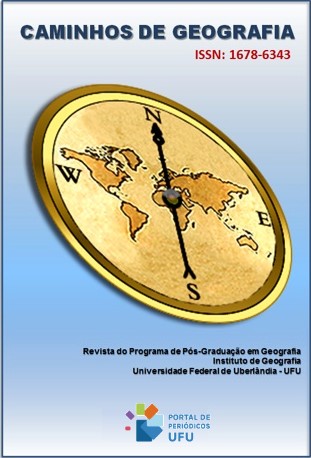ANÁLISE HIPSOMÉTRICA E MORFOESTRUTURAL DO DOMÍNIO VAZA-BARRIS, SERGIPE
DOI:
https://doi.org/10.14393/RCG249466008Palavras-chave:
Controle estrutural, Morfometria, Rede de drenagemResumo
Estudos de parâmetros morfométricos e morfoestruturais são essenciais para o entendimento da paisagem geomorfológica. Avaliam quantitativamente a dinâmica fisiográfica e a atuação da rede de drenagem nos modelados. O Domínio Vaza-Barris é uma unidade geotectônica inserida na Faixa de Dobramentos Sergipana e abrange os estados de Sergipe e Bahia. Inserem-se na unidade quatro bacias hidrográficas: Rio Sergipe, Rio Vaza-Barris, Rio Piauí e Rio Real. Essa pesquisa analisa os índices morfométricos de hipsometria e morfoestrutura aplicados nas áreas das quatro bacias hidrográficas, avaliando quantitativamente o comportamento da drenagem no processo evolutivo da paisagem morfológica e o controle litológico/estrutural na definição e arranjo espacial da drenagem. A metodologia consistiu na compilação dos dados existentes e na aquisição de novos dados através do processamento de imagens de satélite e Modelo Digital de Elevação, no tratamento e interpretação para a elucidação dos fatos. Os índices morfométricos revelaram a intensidade da atuação da rede de drenagem em consonância com a litoestrutura. Conclui-se que as singularidades estruturais, litológicas, tectônicas e fisiográficas interferiram na atuação da rede de drenagem sobre a esculturação do relevo do Domínio Vaza-Barris.
Downloads
Downloads
Publicado
Edição
Seção
Licença
Copyright (c) 2023 Luana Pereira Lima, Hélio Mário de Araújo

Este trabalho está licenciado sob uma licença Creative Commons Attribution-NonCommercial-NoDerivatives 4.0 International License.
Autores que publicam nesta revista concordam com os seguintes termos: a) Autores mantém os direitos autorais e concedem à revista o direito de primeira publicação, com o trabalho licenciado sob a Creative Commons Atribuição-NãoComercial-SemDerivações 4.0 Internacional. b) Autores têm permissão e são estimulados a publicar e distribuir seu trabalho online (ex.: em repositórios institucionais ou na sua página pessoal), já que isso pode gerar alterações produtivas, bem como aumentar o impacto e a citação do trabalho publicado. c) Em virtude de aparecerem nesta revista de acesso público, os artigos são de uso gratuito, com atribuições próprias, em aplicações educacionais e não-comerciais.











